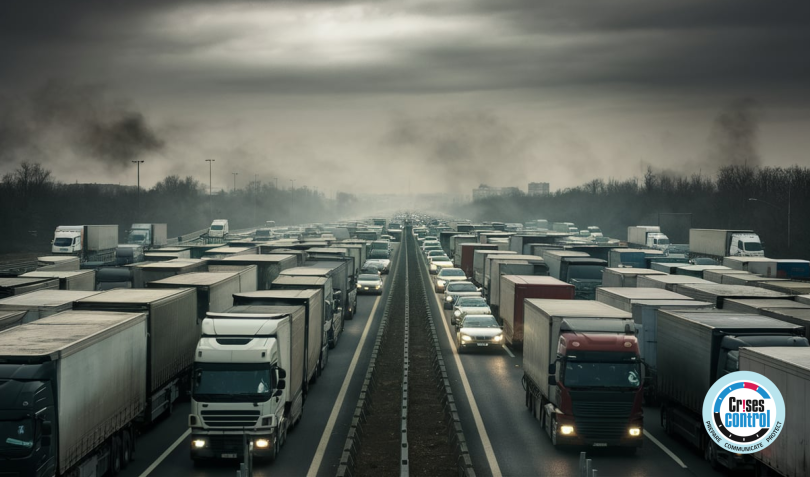The Growing Challenge of Transport Disruptions
Written by Anneri Fourie | Marketing Executive
Transport disruptions can have a significant impact on business operations. Whether it’s a road closure, a public transport strike, or a severe weather event, these disruptions can lead to delays, missed deadlines, and financial losses. For businesses that rely on efficient transportation, the stakes are high. The ability to manage these disruptions effectively can mean the difference between maintaining operational continuity and experiencing a complete breakdown.
This is where emergency alert software becomes indispensable. By enabling real-time communication and streamlined coordination, emergency alert software plays a crucial role in managing transport disruptions, minimising chaos, and ensuring that business operations continue smoothly.
In this blog, we will delve into how this technology transforms transport disruption management, offering practical strategies for keeping all stakeholders informed and reducing operational downtime. We will also highlight how Crises Control’s innovative solutions can help your business stay resilient in the face of transport challenges.
Understanding Transport Disruptions and Their Business Impact
Transport disruptions come in many forms, from unexpected road closures and vehicle breakdowns to more significant events like natural disasters and strikes. These disruptions can create a ripple effect, impacting not just logistics, but also employee availability, customer satisfaction, and overall business continuity.
The Hidden Costs of Transport Disruptions
The financial implications of transport disruptions can be severe. Delayed deliveries can lead to dissatisfied customers and lost revenue. In industries where timing is critical, such as logistics, aviation, and retail, these delays can also damage long-term client relationships and tarnish a company’s reputation. Additionally, the indirect costs, such as overtime pay, emergency supplies, and increased operational expenses, can quickly add up, further straining the company’s resources.
The Need for Effective Crisis Management
Given the potential impact of transport disruptions, effective crisis management is essential. This involves not only having a plan in place, but also being able to communicate and execute that plan swiftly and efficiently. Traditional communication methods, such as emails or phone calls, often fall short during a crisis. They are too slow, too unreliable, and too prone to human error.
This is where emergency alert software comes into play. By providing a reliable, real-time communication platform, it allows businesses to respond to transport disruptions quickly and effectively, ensuring that all stakeholders are informed and that appropriate actions are taken.
The Role of Emergency Alert Software in Transport Disruption Management

Emergency alert software is designed to facilitate rapid, targeted communication during crises, including transport disruptions. Its primary function is to ensure that the right information reaches the right people at the right time, thereby minimising confusion and enabling a coordinated response.
Real-Time Communication: Keeping Everyone Informed
One of the most significant advantages of emergency alert software is its ability to provide real-time communication. During a transport disruption, every minute counts. Delays in communication can lead to missed opportunities to mitigate the impact or even exacerbate the situation. With emergency alert software, businesses can send instant alerts to employees, customers, and partners, ensuring that everyone is aware of the situation as it unfolds.
This real-time communication is especially crucial for companies with large, dispersed teams or those that rely heavily on logistics and transportation. For example, a logistics company facing a sudden road closure can use emergency alert software to reroute its vehicles in real-time, avoiding delays and maintaining delivery schedules.
Targeted Alerts: Reaching the Right People
Another key feature of emergency alert software is its ability to send targeted alerts. Not every disruption affects every employee or department equally. For instance, a public transport strike might primarily impact employees who commute via public transit, while a road closure might be more relevant to the logistics team. By sending targeted alerts, businesses can ensure that only the relevant people receive the information, reducing information overload and enabling a more focused response.
This targeted communication is also beneficial for customer-facing teams. If a transport disruption is likely to delay deliveries, the customer service team can be notified immediately, allowing them to proactively inform customers and manage expectations.
Automated Alerts and Predefined Protocols
During a transport disruption, time is of the essence. Manual communication methods can be slow and prone to error, especially in a high-pressure situation. Emergency alert software often includes automated alerts and pre-defined protocols, allowing businesses to respond quickly and consistently.
For example, if a major transport hub is closed due to an accident, the software can automatically trigger alerts to the logistics team, customer service, and senior management, following a predefined protocol. This automation not only speeds up the response, but also ensures that no critical step is overlooked.
Two-Way Communication: Gathering Real-Time Feedback
Effective crisis management is not just about sending out information—it’s also about gathering it. Two-way communication capabilities in emergency alert software allow businesses to receive real-time feedback from the field. This feedback can include updates on the situation, confirmation that the alert has been received and understood, or even suggestions for alternative solutions.
For instance, if a driver encounters an unexpected road closure, they can use the software to notify the logistics manager immediately, who can then provide alternative routes or instructions. This real-time feedback loop ensures that the response is not only swift, but also adaptive to changing circumstances.
Practical Strategies for Using Emergency Alert Software During Transport Disruptions
To maximise the effectiveness of emergency alert software during transport disruptions, businesses need to adopt a proactive approach. Here are some practical strategies for leveraging this technology to its full potential:
1. Pre-Planning and Simulation
The effectiveness of any crisis response hinges on preparation. Before a transport disruption occurs, businesses should conduct simulations to test their emergency alert software and ensure that all stakeholders are familiar with the procedures. These simulations can help identify potential weaknesses in the communication process and provide an opportunity to refine the protocols.
Pre-planning also involves mapping out potential disruption scenarios and establishing clear response plans for each. By doing so, businesses can ensure that they are ready to act swiftly and effectively when a disruption occurs.
2. Tiered Notification Systems
During a transport disruption, it’s essential to keep everyone informed at each stage of the event. A tiered notification system allows businesses to send different types of alerts as the situation evolves. For example, an initial alert might inform the logistics team of a road closure, while a follow-up alert provides alternative routes. As the disruption is resolved, status updates can be sent to all relevant parties.
This tiered approach ensures that everyone receives the information they need when they need it, without overwhelming them with unnecessary details.
3. Integrating with Other Systems
To provide a holistic response to transport disruptions, emergency alert software should be integrated with other business systems, such as logistics management, HR systems, and customer relationship management (CRM) tools. This integration allows for seamless communication and coordination across different departments and functions.
For example, if a transport disruption affects employee commutes, the HR system can be notified automatically, allowing for adjustments to work schedules or remote work arrangements. Similarly, CRM integration ensures that customer-facing teams are kept in the loop, enabling them to manage customer expectations effectively.
4. Post-Incident Review
After a transport disruption has been managed, it’s essential to conduct a post-incident review. This review should assess the effectiveness of the emergency alert software, identify any areas for improvement, and update the response protocols accordingly. By continually refining the process, businesses can ensure that they are always prepared for future disruptions.
How Crises Control Transforms Transport Disruption Management
Crises Control is a leading provider of emergency alert software designed to help businesses manage crises, including transport disruptions, with ease and efficiency. Here’s how Crises Control’s innovative features can transform your transport disruption management:
1. Ping Mass Notification
Crises Control’s Ping Mass Notification feature allows businesses to send instant, targeted alerts to specific groups or individuals. Whether it’s notifying the logistics team of a road closure or informing employees of a public transport strike, Ping ensures that the right people receive the right information at the right time.
2. Incident Manager
The Incident Manager feature enables businesses to organise and execute their response plans effectively. With the ability to assign tasks, monitor progress, and update stakeholders in real-time, Incident Management ensures a coordinated response to transport disruptions.
3. Task Manager
Crises Control’s Task Manager helps businesses assign and track tasks related to managing transport disruptions. From rerouting vehicles to updating customers, Task Manager ensures that all necessary actions are taken and that nothing falls through the cracks.
4. SOS Panic Button
The SOS Panic Button is a crucial feature for ensuring safety during severe transport-related incidents. Whether it’s an accident or a hazardous weather event, the SOS Panic Button allows employees to signal for immediate help, ensuring their safety and wellbeing.
5. Mobile App
Crises Control’s mobile app ensures continuous operation and communication, even when other systems fail. With the app, employees can receive alerts, provide feedback, and access critical information on the go, ensuring that the response to transport disruptions is swift and effective.
6. Reporting and Audit
Crises Control’s Reporting and Audit feature provides businesses with comprehensive post-incident analysis and reporting capabilities. After a transport disruption has been managed, this functionality allows you to generate detailed reports that capture every action taken during the incident. These reports are invaluable for conducting post-incident reviews, identifying areas for improvement, and ensuring compliance with regulatory requirements. With the ability to audit every step of the response process, businesses can continually refine their strategies and enhance their resilience against future disruptions.
Why Choose Crises Control?
Crises Control offers a comprehensive solution for managing transport disruptions. With its robust features, user-friendly interface, and proven track record, Crises Control is the ideal partner for businesses looking to enhance their crisis management capabilities.
Interested in Crises Control's Success Stories?
Conclusion: Stay Ahead of Transport Disruptions with Crises Control
Transport disruptions are an inevitable part of business operations, but with the right tools, they don’t have to be a crisis. By investing in emergency alert software, businesses can ensure that they are prepared to respond quickly and effectively to any disruption, minimising impact and maintaining operational continuity.
Crises Control offers a powerful, reliable solution for managing transport disruptions and other crises. Don’t let transport challenges derail your business—contact us today to learn more about how Crises Control can help you stay ahead of the curve. Get a free personalised demo and see how our software can transform your crisis management capabilities.
Request a FREE Demo









